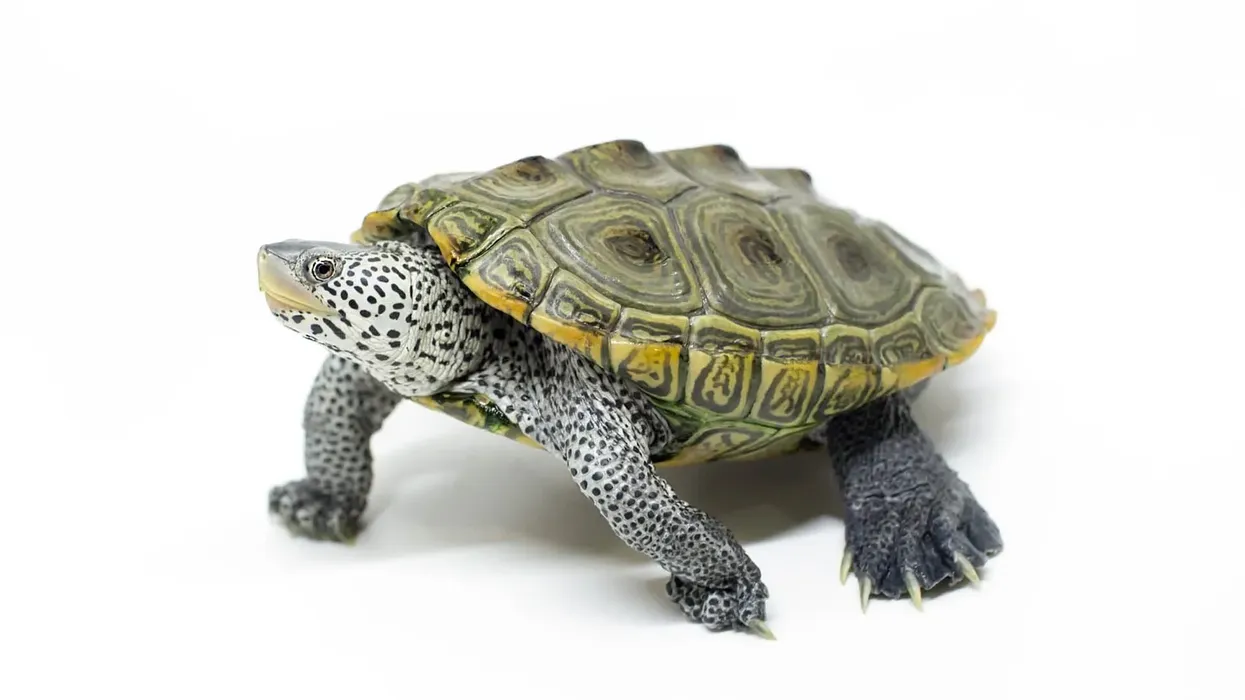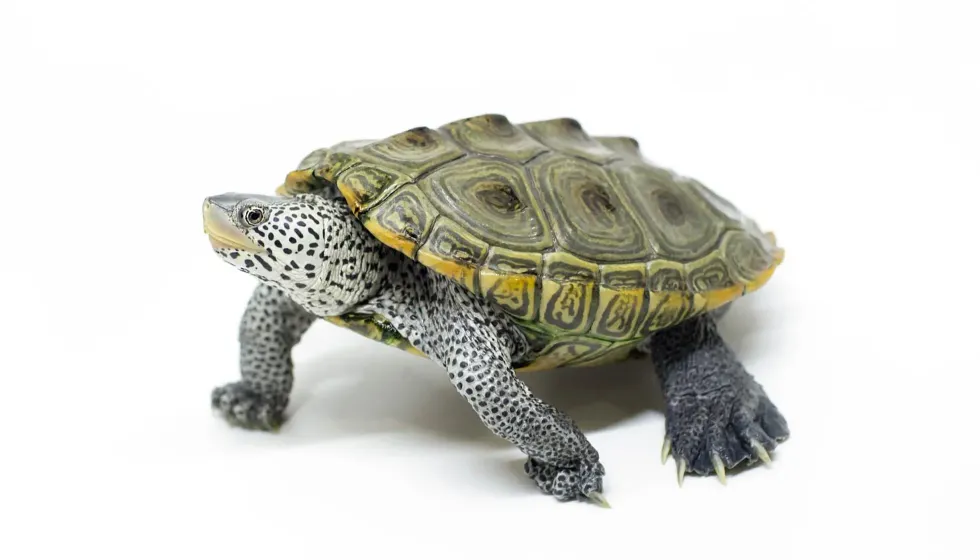If you are a lover of the seas and oceans then we have a perfect treat for you. We present to you a special animal - the diamondback terrapin.
These animals have been named in this manner owing to the diamond-shaped markings that can be found on their carapace.
The primary habitat of these animals are estuaries, salt marshes in Florida, and other nearby areas of the gulf coasts of the US. The eggs are laid in coastal areas when the tidal waves are present as these nesting turtles prefer laying eggs during the high tide.
The wild hatchlings usually stay in freshwater areas like tidal creeks after their birth, however, with age, they start moving to saline conditions. There are seven subspecies of these turtles and among them, the Texas diamondback terrapin and Northern diamondback terrapin are the most popular ones.
These animals have salt glands in their eyes for regulating the salt intake and thus remove the excess salt from the body.
Though these animals are listed as Vulnerable, diamondbacks are still harvested by poachers and traders for the illegal pet trade and food. These turtles have predators like raccoons and skunks who steal their eggs.
Read on to learn more and if you find our content interesting, then do check out rattlesnake facts and coastal taipan facts.
Diamondback Terrapin Interesting Facts
What type of animal is a diamondback terrapin?
The diamondback terrapin (Malaclemys terrapin) is a species of marine turtle that is found in the United States.
What class of animal does a diamondback terrapin belong to?
The diamondback terrapin (Malaclemys terrapin) falls under the class of Reptilia of the Animalia kingdom.
How many diamondback terrapins are there in the world?
The exact population of the diamondback terrapins (Malaclemys terrapin) is unknown. However, we can make an assumption based on their population trends.
As per the International Union for Conservation of Nature or the IUCN Red List, the diamondback terrapin is listed as Vulnerable with the terrapin populations decreasing steadily. If proper preventive steps are not taken then this turtle will slowly slide under the grasp of extinction.
Where does a diamondback terrapin live?
The diamondbacks are a species of aquatic or marine turtle that prefers staying in brackish water, and salt marshes and is found majorly in the coastal areas of the United States of America. The places include the likes of Cape Cod, Massachusetts, Florida Keys, Texas, the Gulf Coast as well as the Eastern coasts.
What is a diamondback terrapin habitat?
The primary habitat of the diamondbacks is brackish water that is found in coastal areas, marshes, tidal flats, creeks, coastal salt marshes, and lagoons. Though these turtles inhabit and thrive well under saline water conditions, they are known to travel to marine or aquatic freshwater areas for drinking purposes.
Who do diamondback terrapins live with?
The diamondback terrapins, Malaclemys terrapin, are highly social or gregarious animals and they are rarely found to be solitary. The diamondback terrapins live in groups with either their siblings or children. These animals are also known to share their resources, thereby making them one of the most social animals in the Reptilia class.
How long does a diamondback terrapin live?
These animals are known to have quite a long lifespan. On average these animals live for around 25-40 years. Their lifespan becomes considerably higher when they are kept in captivity.
How do they reproduce?
Similar to all turtles, the diamondback terrapin, Malaclemys terrapin, also lays eggs. Terrapins mate during early spring and the females are known to dig nests on the ground.
During the hot months of April and May, four to eight eggs in a clutch are laid in the sand by the nesting females during the high tide.
The incubation time for these eggs is comparatively long and it takes almost 60-85 days for the newborn hatchlings to hatch. Males are known to reach sexual maturity earlier than females which takes around seven years before they can mate.
What is their conservation status?
The International Union for Conservation of Nature or the IUCN Red List has listed the diamondback terrapin as a Vulnerable species. The population trend also shows that the population has been decreasing steadily over the years.
A major reason for their vulnerability is due to human activities that involve the likes of hunting, harvesting, habitat loss, and others. In the early 1900s, this species was on the verge of extinction by the extensive farming by humans for their food consumption.
Diamondback Terrapin Fun Facts
What do diamondback terrapins look like?
Owing to their dark carapace the diamondback terrapin is considered one of the darkest turtles to have ever walked on this planet. Unlike other turtle species, the diamondback terrapin has a higher shell, a white upper lip, and a grayish-colored carapace.
The carapace is filled with diamond-shaped black markings thus giving them this unique name. The skull of this turtle is exceptionally long and is also known to have an arch. The hind legs are relatively larger in comparison to the forelimbs.
Sexual dimorphism is significantly higher when both sexes are different in size from one another. The male species are relatively smaller in size and the females are generally large.

How cute are they?
The cuteness in reptiles is extremely subjective and differs from person to person. In the case of diamondback terrapins, it is no different. While some people find this turtle to be extremely adorable, others hardly care at all.
How do they communicate?
There is very little information known as to how diamondback terrapins communicate. However, since they are a species of turtles, it is expected that their means of communication are likely to be similar to other turtles of different species.
Turtles communicate with each other using visual cues. Since turtles don't have any vocal cords, not much sound is produced by these animals, however, some small sounds are produced which could be a sign of communication.
How big is a diamondback terrapin?
The diamondback terrapin is an average-sized turtle and it has an average carapace length of 5.1-7.5 in or 13-19 cm. The males are usually smaller in size in comparison to their female counterparts. They are almost of the same size when compared to common turtles that have an average length of 4-10 in or 10-25 cm.
How fast can a diamondback terrapin swim?
Due to insufficient data, the exact speed at which the diamond terrapins swim is unknown. However, these turtles are excellent swimmers. Though unlike sea turtles they don't have flippers, their strong hind webbed feet make them powerful swimmers.
How much does a diamondback terrapin weigh?
Diamond terrapins are known to have an average weight of around 25.3 oz or 720 g. Owing to their small sizes the males are lighter (11 oz or 300 g) when compared to the females (18 oz or 500 g).
What are the male and female names of the species?
There is no distinct name that has been assigned to the males and the females of the diamondback terrapins. Thus they are referred to as male diamondback terrapin and female diamondback terrains.
What would you call a baby diamondback terrapin?
Like all baby turtles, since they hatch from eggs they are termed hatchlings. So in the case of diamondbacks, the young ones are known as diamondback terrapin hatchlings.
What do they eat?
Diamondback terrapins are omnivorous animals and thus they are known to feed on both plant and animal matter. However, they are primarily carnivores and love eating flesh.
Their diet consists of small fishes, crustaceans like snails, crabs, mussels, insects, carrions, and mollusks. These animals crush their food with their powerful jaws before ingesting them. These animals are also known to have plant matter like algae on their diet.
Are they poisonous?
No. Diamondback terrapins are not poisonous.
Would they make a good pet?
No. The Diamondback terrapins don't make very good pets.
They are wild animals and thus their habitat is out in the wild. Moreover, in captivity, these animals are known to contract numerous diseases which drastically reduce their lifespan. Lastly, these animals are Vulnerable and only a small portion of their population is alive today, so keeping them as pets is not advised.
Did you know...
The female diamondback terrapin can produce eggs for many years after mating for a single time.
Male fetuses hatch below 82.4 F (28 C) while the females hatch above 86 F (30 C) during their incubation period. This is a unique process that occurs in many turtles and this amazing process is called temperature-dependent sex determination.
Is the diamondback terrapin endangered?
The International Union for Conservation of Nature or the IUCN Red List has placed diamondback terrapins under the category of Vulnerable. The population trend of this species is also concerning as it has been constantly on the decline over the years.
The main reasons for them being vulnerable are extensive hunting and consumption by humans. In the early 1900s, they were thought to be extinct owing to their extensive harvesting of food.
Are diamondback terrapins social?
Diamondback terrapins are highly interactive animals. Their social nature is indicated by their behavior. These animals are rarely solitary and the diamondback terrapins live in small groups throughout their habitat.
They are known to reside happily with their family which includes their siblings and young ones. These animals also share food and other resources with other diamondback terrapins. Their helpful and sharing nature can also be seen when they share rocks where they bask in the sun.
Here at Kidadl, we have carefully created lots of interesting family-friendly animal facts for everyone to discover! Learn more about some other reptiles from our impressed tortoise fun facts and gargoyle gecko facts pages.
You can even occupy yourself at home by coloring in one of our free printable diamond terrapin coloring pages.









